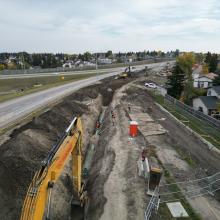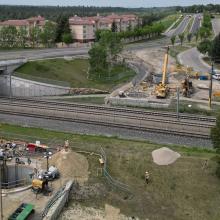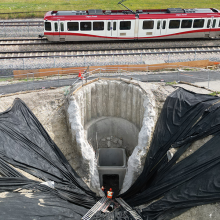Image set

Related services
Related sectors
Related regions
Opening article section
Article section
Rich text
Behind most cool projects is an engineer. Behind the Fish Creek West Sanitary Trunk Project, a very cool project, one of those engineers was Sarah Fratpietro, a Project Manager on our team. She’s busy, but never too busy to talk about this incredible project.
Sarah was drawn from Ontario to life out west not because of a lure of the mountains, but for the work. As a new engineering graduate, she was looking for an opportunity to work on interesting, challenging, and diverse projects - exactly what she found when she joined the MPE a division of Englobe team. Here, she found more than just a steady stream of cool projects, she found a multidisciplinary team, and community of experts, that supported and mentored her to deliver exceptional work.
Today, some 20 years later, Sarah is wrapping up work for one of her most memorable projects to date, the Fish Creek West Sanitary Trunk project. In a nutshell, this project was anything but standard and pushed the team, including Sarah, to get creative. When successfully completed, the new sanitary pipeline would cross the CP Railway right-of-way and the City of Calgary’s existing Light Rail Transit (LRT) tracks utilizing an inverted siphon installed by microtunnelling. It would then be tied into the existing pipeline on the other side of the LRT tracks.
Media
Image set

Rich text
Q. What was MPE a Division of Englobe’s role in the project?
MPE was the Prime Consultant for the City of Calgary for the Fish Creek West Sanitary Trunk project. We were involved from the planning stages all the way to the end of construction. The project involved engineering services to upgrade the capacity for the Fish Creek West Sub-Trunk wastewater pipeline that runs from Tsuut’ina Nation to the City’s infrastructure at the Macleod Trail and Canyon Meadows Drive intersection. We reviewed five potential upgrade options, produced cost estimates, and undertook a Triple Bottom Line analysis to determine the preferred option with the City. The construction involved installation of 7 km of 525-750mm diameter wastewater pipeline within City roads and boulevards. It included crossing of the LRT/CP Railway tracks with 1500 mm diameter concrete casing pipe by microtunnel installation, and 650 m length of 1200 mm diameter concrete pipeline installed in 14 Street and Canyon Meadows Drive by microtunnel installation. There were also three road crossings where the pipeline was installed with an augerbore so the intersections were not disturbed.
Q. What made this project so special / unique for you?
This was my first project that involved microtunnelling so it was an exciting opportunity to learn about the process and utilization. We worked with a Subconsultant, BlueFox Engineering, for the microtunnel design and construction inspections, and installed pipe by microtunnelling in three locations at a depth of up to 12 m. From a learning perspective, this was an incredible experience and really interesting project filled with unique engineering challenges that we overcame as a team.
Rich text
Q. What were the engineering achievements for the project?
We collaborated with the City and provided a solution to upgrade the wastewater trunk with the least impact to the community and to the wastewater operation. Various trenchless technologies (microtunnelling and augerboring) were used to install the pipeline in areas that excavation of the pipeline would have disturbed residents’ backyards and crossed the LRT and CP Rail tracks. There was extensive planning with the City which included three workshops with stakeholders to review the impact of each of the upgrade options and to determine the best option.
Q. What was the biggest challenge the team faced for the project?
The biggest challenge the team faced for design was that the new wastewater pipeline had to cross the existing CP Railway ROW that also included the City’s LRT tracks, and the pipe had to tie into the existing wastewater main on the other side of the tracks. The wastewater pipeline elevation was restricted due to the shallow tie-in elevation and would have conflicted with a water transmission main, resulting in not meeting the required depth of bury needed to cross the CP Rail tracks as a gravity main. The soil material in this area was also determined to be gravelly with cobbles which is a difficult material for trenchless crossings. Our team reviewed multiple options for this crossing and ultimately decided that lowering the elevation of the sanitary pipeline crossing with an inverted siphon installed by microtunnel methodology would be the safest and most suitable option. We designed the inverted siphon to have the capacity for the low initial flows and for the future ultimate flows that are projected to be significantly higher.
Article quote
Rich text
Q. What makes this project memorable for you?
While the project itself was very interesting and presented many great learning opportunities, it was the team that really made it memorable for me. The team that we started with on this project in 2020 is still together for the most part and we have become a very close-knit team. We have had regular weekly meetings with the City Project Manager for the last 3.5 years and I will miss working with this team when the project is complete.
Q. Who is a mentor that had the greatest impact on you?
I have had many great mentors over the years, but the one who had the greatest impact would be Dan Parker. He was my supervisor and the Office Manager when I first started at MPE in 2001 and we worked closely together for 10 years. I was hired at MPE directly from university and I had very minimal experience, but Dan always took the time to help me out, point me in the right direction, and mentor me in all the important aspects of the job. I have the outmost respect for Dan and miss working with him since his retirement.
Q. What currently motivates you?
My biggest motivation is my daughter. As an engineer, I want to help shape a better world for her and teach her that having a strong work ethic and pride in a job well done is important regardless of the career path she chooses.
Q. What advice would you have for students, especially young girls, interested in becoming an engineer?
The one thing that surprised me about being an engineer on the consulting side is the amount of social interaction that would be required. When I was in school, I thought being an engineer meant sitting in an office alone and completing design work 100% of the time. My career involves working in a team environment, participating in meetings, and working out solutions with the design team. In addition, an important part of the job is developing ongoing relationships with clients. I think this social aspect comes naturally to a lot of women and that we find this very enjoyable. If young girls who were contemplating being an engineer knew more about this part of the job, I think it would encourage them to enter this field of work. Being an engineer does not mean toiling away in solitude!
Media
Image set
